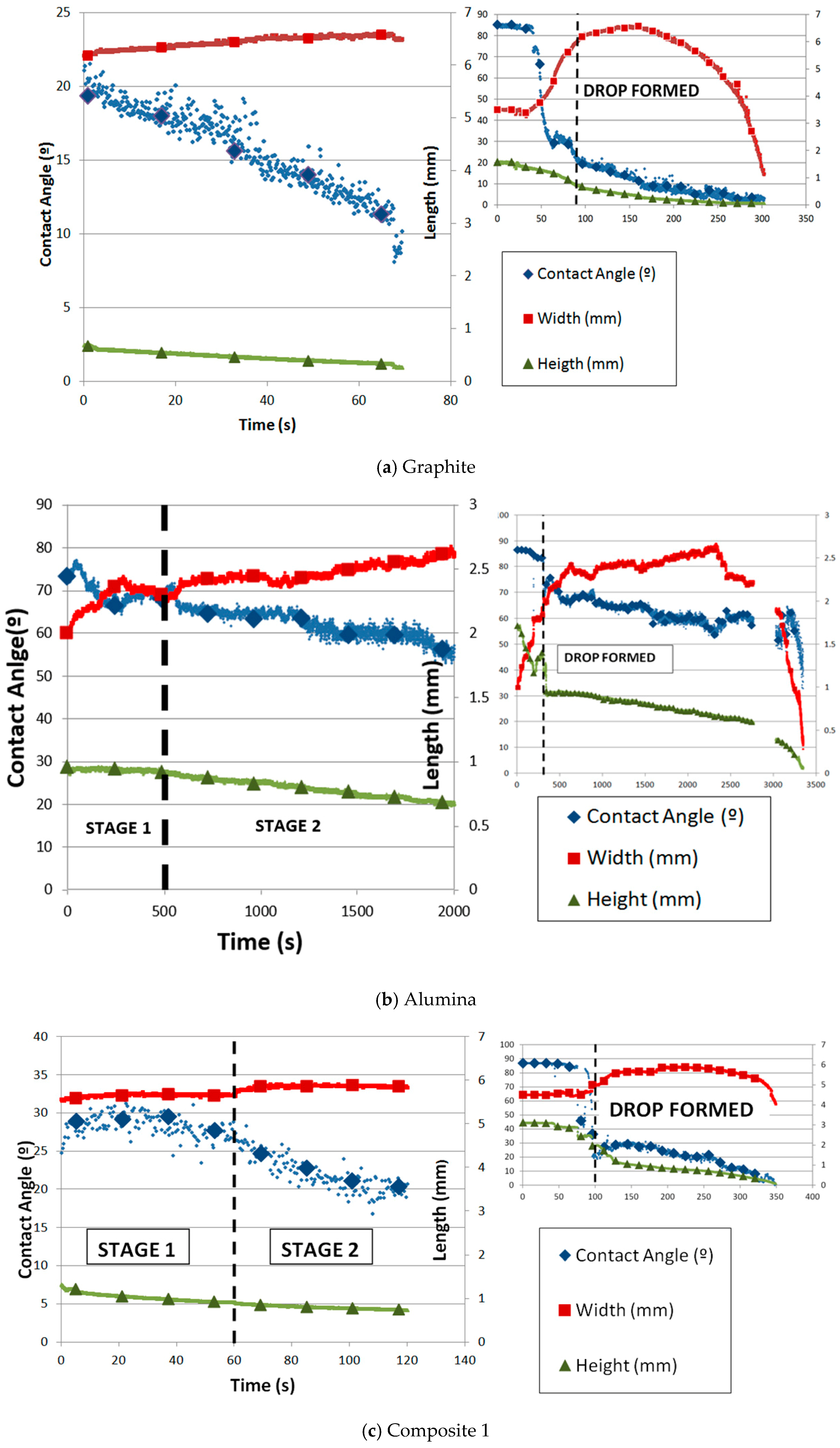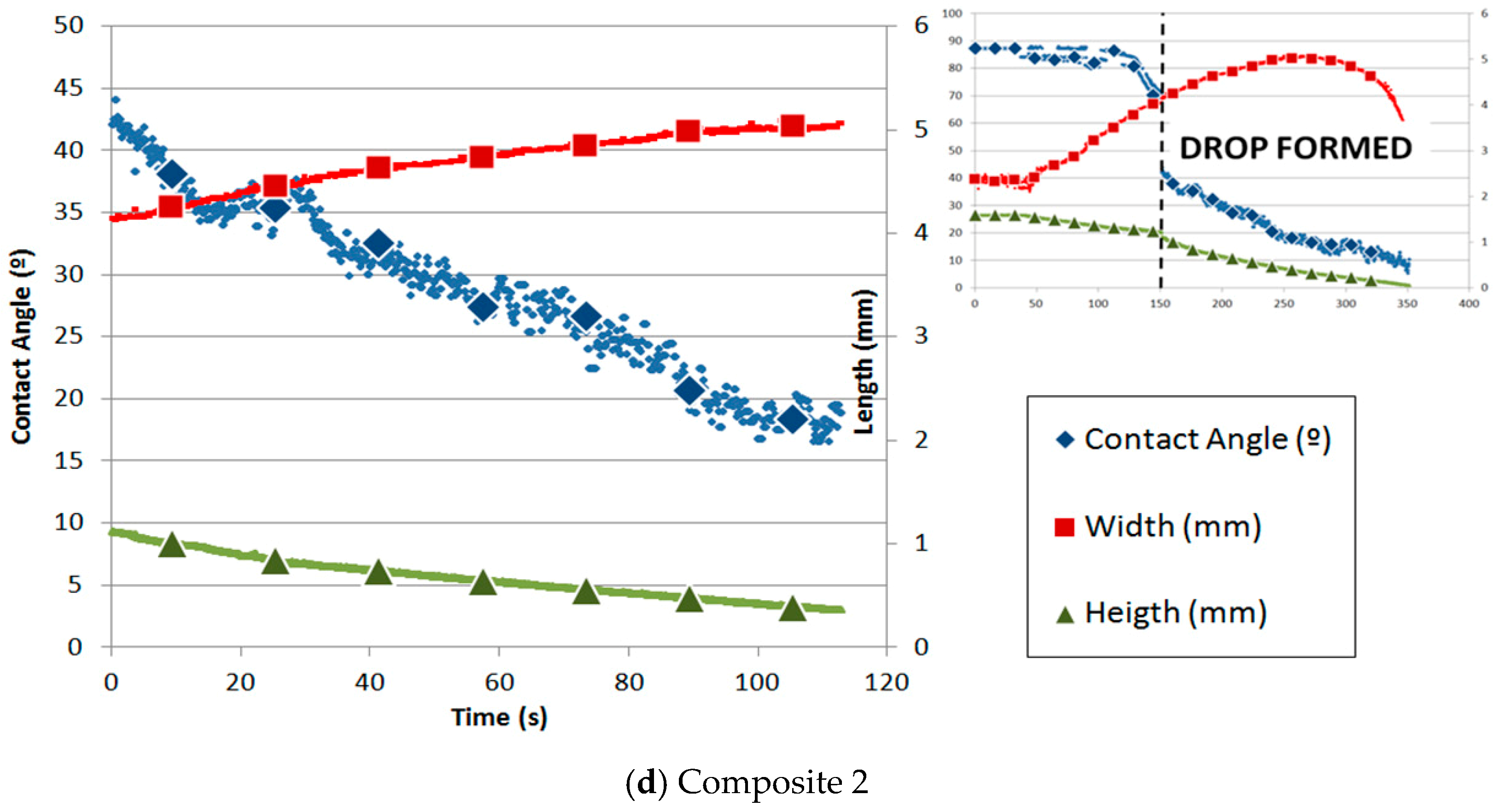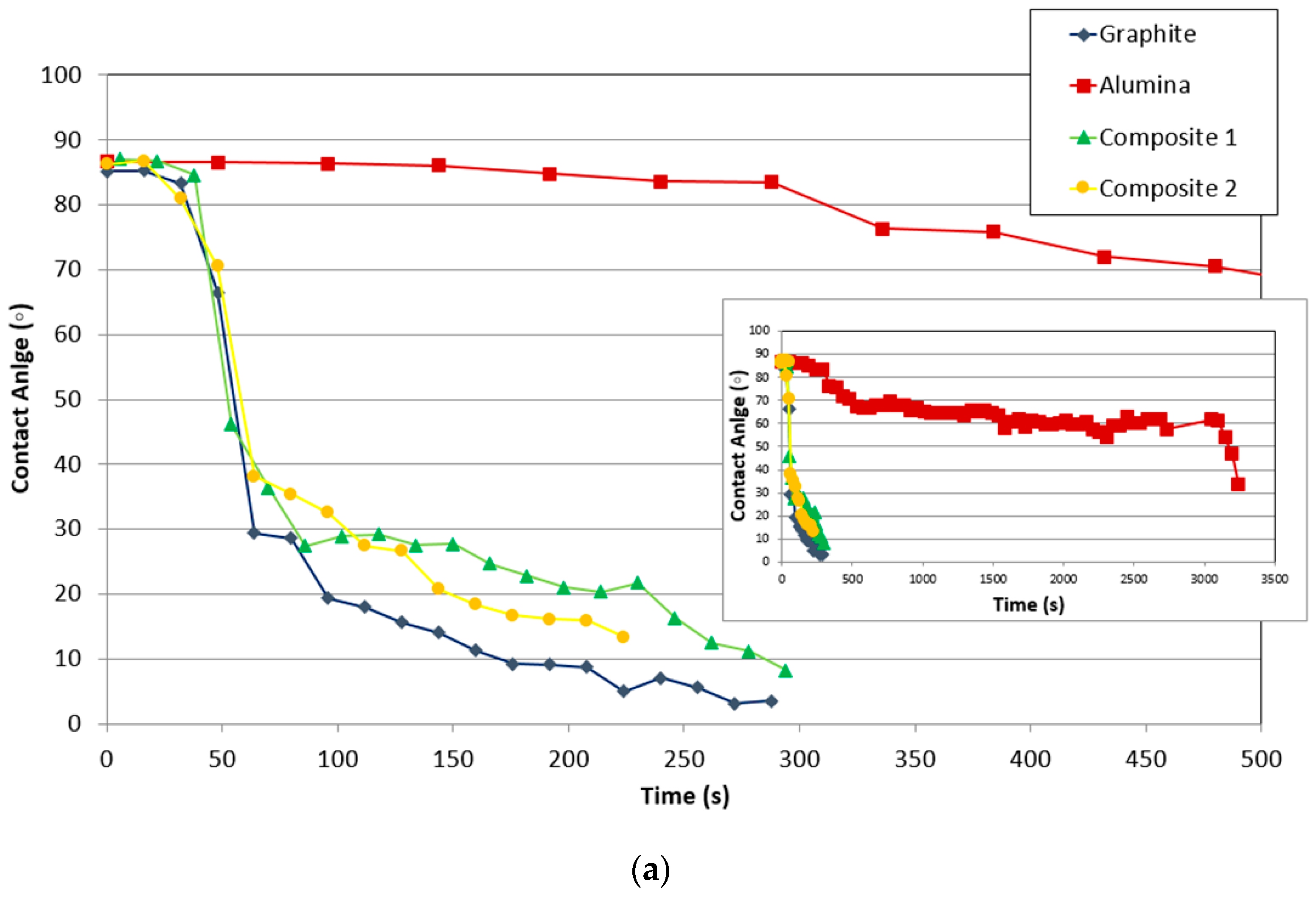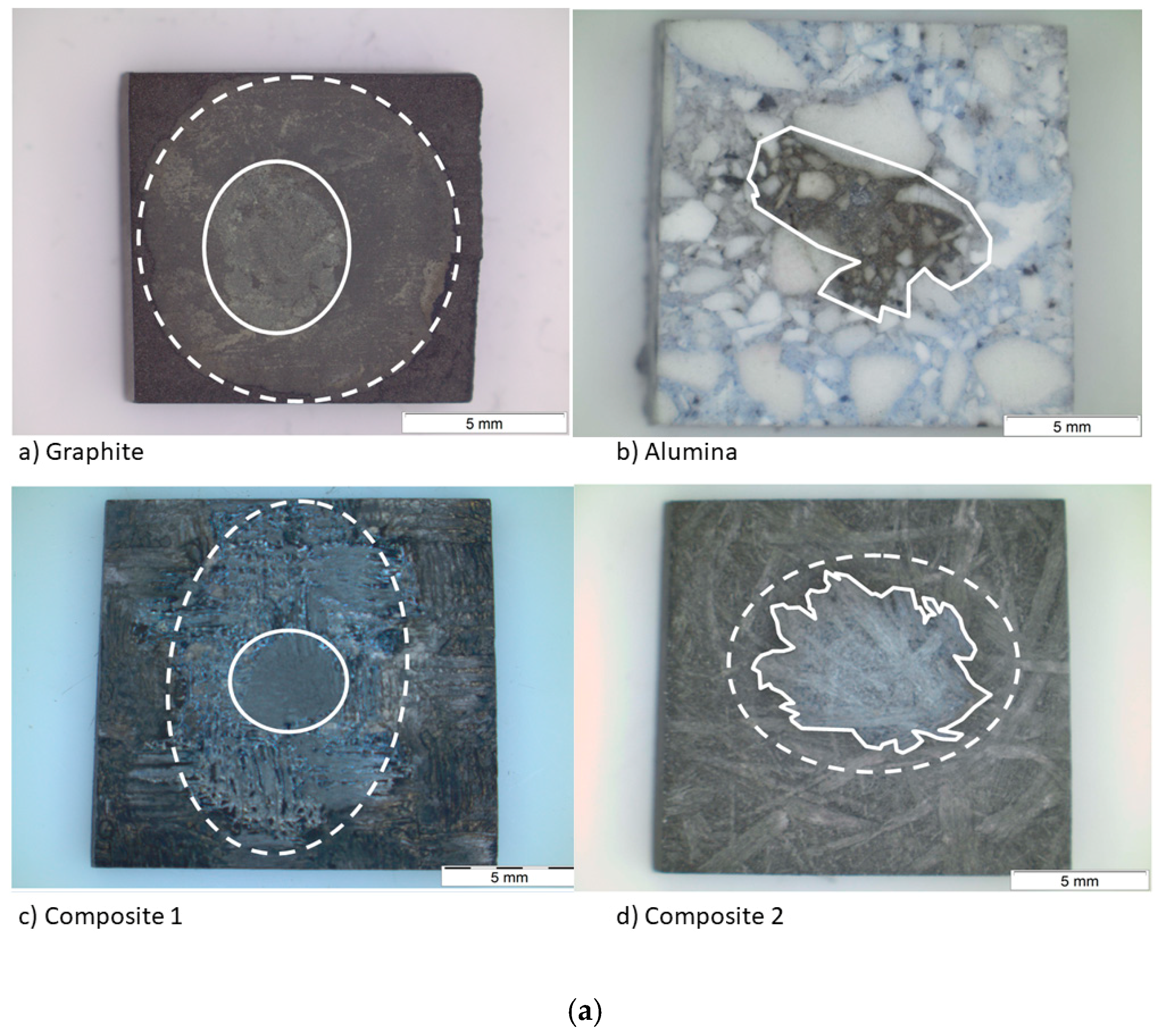Wettability and Infiltration of Liquid Silicon on Graphite Substrates
Abstract
:1. Introduction
2. Materials and Methods
3. Results
3.1. Porosity Analysis
3.2. Crystallinity Analysis
3.3. Sessile Drop Tests
3.4. Wettability, Infiltration and Reactivity
4. Discussion
5. Conclusion
- The reaction of triple line silicon-graphite manages the phenomena of infiltration and wettability. This is showed by the linear variation of contact angle and parameters of silicon drop with the time in the substrates: Graphite, composite 1, and composite 2. However, the graphics of composite 1 indicated that the reaction has been hindered by the roughness. In the case of Alumina, due to the presence of oxygen, a passive layer is likely formed and subsequently eliminated by chemical reactions of silicon-oxygen [6,19], delaying the processes.
- Regarding contact angle and infiltration behavior, Alumina is the best material studied in this paper against molten silicon. However, regarding the reactivity, silicon was contaminated so that this material is not recommended for solar silicon application.
- Composite 2 is compatible with the application, as it shows a high initial contact angle, good behavior in spreading and infiltration in comparison with the other materials, and also contains unreacted silicon at the surface.
Author Contributions
Funding
Acknowledgments
Conflicts of Interest
References
- Lynch, D. Winning the global race for solar silicon. JOM 2009, 61, 41–48. [Google Scholar] [CrossRef]
- Binetti, S.; Libal, J.; Acciarri, M.; Di Sabatino, M.; Nordmark, H.; Øvrelid, E.J.; Walmsley, J.C.; Holmestad, R. Study of defects and impurities in multicrystalline silicon grown from metallurgical silicon feedstock. Mater. Sci. Eng. B 2009, 159–160, 274–277. [Google Scholar] [CrossRef]
- Safarian, J.; Tranell, G.; Tangstad, M. Processes for upgrading metallurgical grade silicon to solar grade silicon. Energy Procedia 2012, 20, 88–97. [Google Scholar] [CrossRef]
- Safarian, J.; Xakalashe, B.; Tangstad, M. Vacuum Removal of the Impurities from Different Silicon Melts. In Proceedings of the 26th European Photovoltaic Solar energy conference and exhibition, Hamburg, Germany, 5 September 2011; pp. 1810–1813. [Google Scholar]
- Flamant, G.; Kurtcuoglu, V.; Murray, J.; Steinfeld, A. Purification of metallurgical grade silicon by a solar process. Sol. Energy Mater. Sol. Cells 2006, 90, 2099–2106. [Google Scholar] [CrossRef]
- Israel, R.; Voytovych, R.; Protsenko, P.; Drevet, B.; Camel, D.; Eustathopoulos, N. Capillary interactions between molten silicon and porous graphite. J. Mater. Sci. 2010, 45, 2210–2217. [Google Scholar] [CrossRef]
- Ciftja, A.; Engh, T.A.; Tangstad, M. Wetting properties of molten silicon with graphite materials. Metall. Mater. Trans. A 2010, 41, 3183–3195. [Google Scholar] [CrossRef]
- Dezellus, O.; Jacques, S.; Hodaj, F.; Eustathopoulos, N. Wetting and infiltration of carbon by liquid silicon. J. Mater. Sci. 2005, 40, 2307–2311. [Google Scholar] [CrossRef]
- Eustathopoulos, N.; Israel, R.; Drevet, B.; Camel, D. Reactive infiltration by Si: Infiltration versus wetting. Scr. Mater. 2010, 62, 966–971. [Google Scholar] [CrossRef]
- Li, J.G.; Hausner, H. Wetting and infiltration of graphite materials by molten silicon. Scr. Metall. Mater. 1995, 32, 377–382. [Google Scholar] [CrossRef]
- Whalen, T.J.; Anderson, A.T. Wetting of SiC, Si3N4 and Carbon by Si and Binary Si Alloys. J. Am. Ceram. Soc. 1975, 396–399. [Google Scholar] [CrossRef]
- Rubio, P.J.Y.; Hong, L.; Saha-Chaudhury, N.; Bush, R.; Sahajwalla, V. Dynamic wetting of graphite and SiC by ferrosilicon alloys and silicon at 1550 °C. ISIJ Int. 2006, 46, 1570–1576. [Google Scholar] [CrossRef]
- Caccia, M.; Amore, S.; Giuranno, D.; Novakovic, R.; Ricci, E.; Narciso, J. Towards optimization of SiC/CoSi2 composite material manufacture via reactive infiltration: Wetting study of Si-Co alloys on carbon materials. J. Eur. Ceram. Soc. 2015, 35, 4099–4106. [Google Scholar] [CrossRef]
- Oro, R.; Campos, M.; Torralba, J.M. Study of high temperature wetting and infiltration for optimizing liquid phase sintering in low alloy steels. Powder Metall. 2012, 55, 180–190. [Google Scholar] [CrossRef]
- Beyssac, O.; Rouzaud, J.-N.; Goffé, B.; Brunet, F.; Chopin, C. Graphitization in a high-pressure, low-temperature metamorphic gradient: A Raman microspectroscopy and HRTEM study. Contrib. Mineral. Petrol. 2002, 143, 19–31. [Google Scholar] [CrossRef]
- Eustathopoulos, N.; Nicholas, M.G.; Drevet, B. Wettability at High Temperatures; Elsevier: Oxford, UK, 1999. [Google Scholar]
- Israel, R. Etude des interactions entre silicium liquid et graphite pour application à l’élaboration du silicium photovoltaïque. Available online: http://tel.archives-ouvertes.fr/tel-00434104/ (accessed on 22 February 2019).
- Yuan, Z.; Huang, W.L.; Mukai, K. Wettability and reactivity of molten silicon with various substrates. Appl. Phys. A 2004, 78, 617–622. [Google Scholar] [CrossRef]
- Camel, D.; Drevet, B.; Eustathopoulos, N. Capillarity in the processing of photovoltaic silicon. J. Mater. Sci. 2016, 51, 1722–1737. [Google Scholar] [CrossRef]
- Novakovic, R.; Giuranno, D.; Caccia, M.; Amore, S.; Nowak, R.; Sobczak, N.; Narciso, J.; Ricci, E. Thermodynamic, surface and structural properties of liquid Co-Si alloys. J. Mol. Liq. 2016, 221, 346–353. [Google Scholar] [CrossRef] [Green Version]
- Drevet, B.; Eustathopoulos, N. Wetting of ceramics by molten silicon and silicon alloys: A review. J. Mater. Sci. 2012, 47, 8247–8260. [Google Scholar] [CrossRef]
















| Material | Apparent Density | Total Density | Archimedes Porosity % | Tomography Porosity % |
|---|---|---|---|---|
| Graphite | 2.07 | 1.72 | 17 | 22.3 |
| Alumina | 4.23 | 3.07 | 27.43 | 27.92 |
| Composite 1 | 2.24 | 1.52 | 32.33 | 32.3 |
| Composite 2 | 1.72 | 1.38 | 19.51 | 23.89 |
| Ratio | Graphite | Composite 1 | Composite 2 |
|---|---|---|---|
| D1/(D1 + D2 + G) | 0.36 | 0.55 | 0.39 |
| Authors | Li and Hausner [10] | Dezellus et al. [8] | Whalen and Anderson [11] | Ciftja et al. [7] | Israel et al. [6] | This Study | ||
|---|---|---|---|---|---|---|---|---|
| Initial contact angle (°) | ~18 | ~48 | 146 | 25–30 | ~100 | ~95 | ~90 | 23.6 |
| Final contact angle (°) | 3° | 35° | 35°–40° | 5°–15° | 0° | ~30° | ~12° | 0° |
| Temperature | 1430 °C | 1430 °C | 1502 °C | 1600 °C | 1460 °C | 1424° | ||
| Atmosphere | Argon | Vacuum | Vacuum | Argon | Argon | Argon | ||
| Ra (µm) | 3.18 | 0.005 | 0.002–0.004 | - | 1.27 | 0.09 | 0.77 | 4.83 |
| Silicon mass (mg) | 60 | - | - | 10–50 | - | 50 | ||
| Porosity (%) | - | - | - | 18 | 15 | 17 | ||
| Av pore diameter (µm) | - | - | - | 2.5 | 2.3 | 9.32 | ||
| Kinetics Rate | Graphite | Alumina | Composite 1 | Composite 2 | |||||
|---|---|---|---|---|---|---|---|---|---|
| Before Drop | After Drop | Stage 1 | Stage 2 | Before Drop | Stage 1 | Stage 2 | Before Drop | After Drop | |
| Uinf | 0.012 | 0.009 | 4.0 × 10−5 | 2.0 × 10−4 | 0.027 | 0.005 | 0.002 | 0.005 | 0.006 |
| Uspr | 0.025 | 0.011 | 2.5 × 10−4 | 1.0 × 10−4 | 0.010 | 5.5 × 10−4 | 0.004 | 0.008 | 0.006 |
| Uinf/Uspr | 0.458 | 0.782 | 0.160 | 2.000 | 2.706 | 9.273 | 0.600 | 0.654 | 0.95 |
| Parameters | Graphite | Alumina | Composite 1 | Composite 2 |
|---|---|---|---|---|
| Internal radius (mm) | 1.85 | - | 1.81 | 2.10 |
| External radius (reff) (mm) | 3.53 | 3.87 | 5.73 | 4.85 |
| Maximum radius (mm) | 3.68 | 1.39 | 4.16 | 3.46 |
| Infiltration (htotal) (mm) | 0.98 | 5.02 | 0.64 | 0.82 |
| Temperature | 1424 °C | |||
| Atmosphere | Argon | |||
| Ra (µm) | 4.83 | 3.29 | 4.48 | 7.02 |
| Porosity | 22.3% | 27.92% | 32.3% | 23.89% |
| Parameters | Graphite | Alumina | Composite 1 |
|---|---|---|---|
| % Porosity | 23.3 | 32.3 | 23.89 |
| Grade of crystallinity | 0.36 | 0.55 | 0.39 |
| Ra (µm) | 4.83 | 3.29 | 7.02 |
| Maximum distance infiltrate | 0.98 | 0.64 | 0.82 |
| Average pore size | 9.32 | 26.25 | 11.62 |
| Uinf (µm/s) | 9 | 3.9 | 6.1 |
| Uspr (µm/s) | 11.5 | 1.4 | 6.4 |
| Initial Contact Angle | 23.6° | 27.69° | 43.8° |
| Uinf/Uspr | 0.782 | 0.28 | 0.95 |
© 2019 by the authors. Licensee MDPI, Basel, Switzerland. This article is an open access article distributed under the terms and conditions of the Creative Commons Attribution (CC BY) license (http://creativecommons.org/licenses/by/4.0/).
Share and Cite
Casado, A.; Torralba, J.M.; Milenkovic, S. Wettability and Infiltration of Liquid Silicon on Graphite Substrates. Metals 2019, 9, 300. https://doi.org/10.3390/met9030300
Casado A, Torralba JM, Milenkovic S. Wettability and Infiltration of Liquid Silicon on Graphite Substrates. Metals. 2019; 9(3):300. https://doi.org/10.3390/met9030300
Chicago/Turabian StyleCasado, Almudena, Jose Manuel Torralba, and Srdjan Milenkovic. 2019. "Wettability and Infiltration of Liquid Silicon on Graphite Substrates" Metals 9, no. 3: 300. https://doi.org/10.3390/met9030300
APA StyleCasado, A., Torralba, J. M., & Milenkovic, S. (2019). Wettability and Infiltration of Liquid Silicon on Graphite Substrates. Metals, 9(3), 300. https://doi.org/10.3390/met9030300







